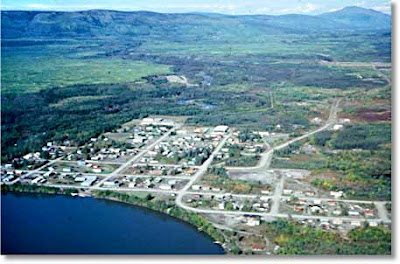 Mayo Village's weather is influenced by both arctic and polar fronting. The polar front is the boundary between the cold, polar air masses and warm tropical air masses. As the temperature gradient between these air masses increases so does the potential for cyclogenesis. The arctic front, like the polar front, is dependent on temperature gradients between air masses. Arctic fronting typically produces precipitation in the form of snow. The Arctic front effects Mayo Village the most during spring and autumn by enhancing cloudiness. |
Graphic Source: Air Masses. National Weather Service JetStream-Online School for Weather. NOAA. Updated: 2010 January 5. Accessed: 2011 October 22. http://www.srh.noaa.gov/jetstream/synoptic/airmass.htm |
 |
| http://www.packyabags.com/canada/rubyrange/14daywinter.htm |
 |
In the summer increased solar radiation results in a relatively little surface cooling, weakly enhancing the temperature of air column near the ground. Results are relatively unstable conditions in the lower layers of air column. Dry conditions of the ground surface up to a high altitude of the air column would tend to result in lack of cloudiness or precipitation, but as observed in the graphic below, this is not the case in Mayo.
Graphic Source: Air Masses and Fronts. Firemodels.org. Accessed: 2011 October 22. http://www.firemodels.org/downloads/.../pms_425_Fire_Wx_ch_08.pdf
 | |||||||||
Mayo Village, surrounded by water in various forms, observes enhanced precipitation and weak cyclonic activity in the summer. The increased sunlight and melting of semi permanent ground allows Mayo to thrive with vegetation that escalates moisture content of the air through the process of transpiration and evaporation from the water bodies that surround the area; increasing precipitation and cloudiness. Graphic Source: Water Cycle. 2011. Yukon Water. Government of Yukon. Last Updated: 2011 MAY 5. Accessed: 2011 OCT 22. Here are the weather maps (water vapor, wind direction, water saturation, etc) for Mayo Village for October 29 2011. Illustrated is current jet stream location and orographic blocking on southwestern border of Yukon. The polar jet stream migrates south during the winter and north during the summer. Mayo Village rarely observes summer temperatures higher than 80 F. Graphics Source: Satellite Images (data courtesy of NOAA). Weather Office, Canada. Updated: 2011 OCT 12. Accessed: 2011 OCT 29. http://www.weatheroffice.gc.ca/satellite/index_e.html
|















